#polychrome earthenware
Text
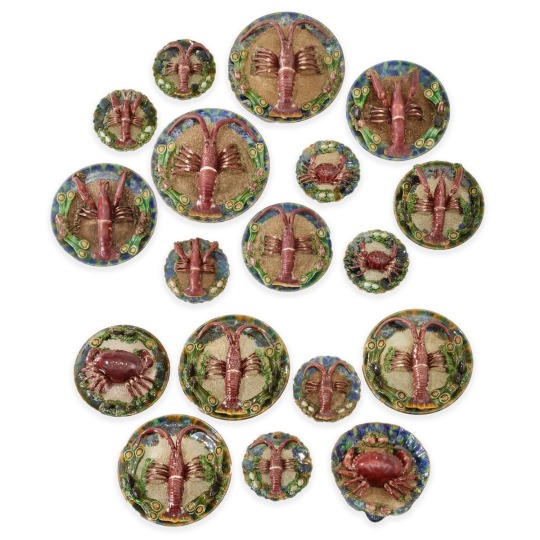
20th c., Portugal and/or France, polychrome tin glazed earthenware, decorated with realistically
modeled shellfish on a sand-textured ground, including spiny lobster plates.
Millebros
42 notes
·
View notes
Text
For #WorldParrotDay 🦜:

William De Morgan (English, 1839-1917)
Scarlet Macaw and Blue Fronted Amazon Parrot tile panel, 1888-97
Tin-glazed earthenware, W 518 x H 1283 x D 48 mm
De Morgan Collection C_WDM_0271b
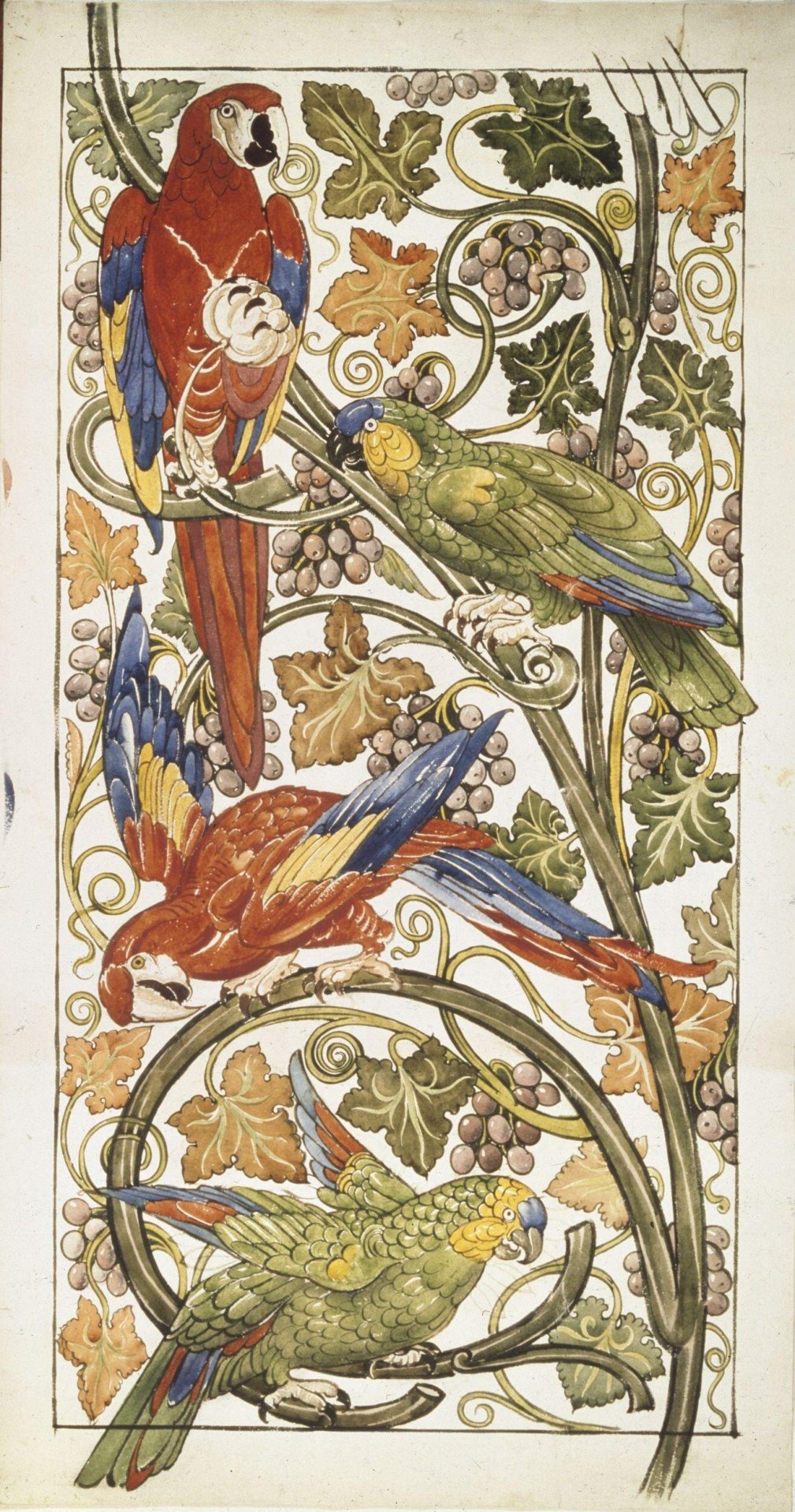
William De Morgan (English, 1839-1917)
Design for a tile panel with parrots, 1888-97
polychrome watercolour on paper, H 91.4 x W 45.7 cm
Victoria and Albert Museum E.404-1917
#animals in art#animal holiday#european art#birds in art#19th century art#bird#tilework#parrot#parrots#World Parrot Day#birds#William De Morgan#De Morgan Collection#tile panel#Scarlet Macaw#macaw#Blue-Fronted Amazon#ceramics#decorative arts#V&A Museum#painting#watercolor
21 notes
·
View notes
Text
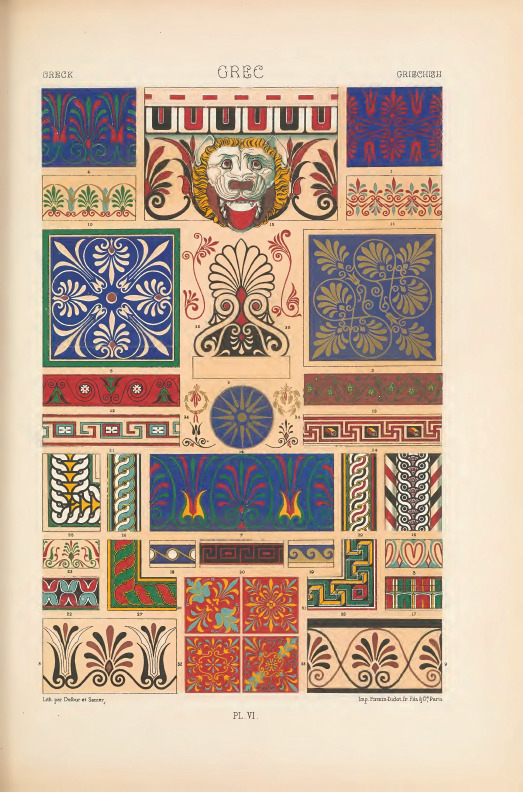

Albert Racinet's "Polychrome Ornament," 1869
PLATE VI.
GREEK AND GRECO-ROMAN ANTIQUITIES:
SPECIMENS OF POLYCHROMATIC DECORATION.
THE accompanying plate contains numerous specimens of polychromatic decoration, taken from various periods of Greek Art, commencing from the date of the monuments in AEgina, or the Parthenon, down to that which may be called the Greco-Roman period. The colours are copied from sketches by the most competent artists.
The following is a list of the subjects in the plate, Virith references to the authorities from which they are selected :-
Nos. 1, 2, 3.-Frieze and corona ornaments, from the restoration of the Parthenon, by M. Paccard. (Ecole des Beaux-Arts ; Roman section.)
No. 4.-Ornaments from the frieze of the Temple of tho Wingless Victory at Athens. (Lebas, Voyage archeologie en Grece et en Asie Mineure, I., pl. 8, No. 1.)
No, 5.-Ancient fragment from a panel of a corona. (Lebas, id., II., pl. 6, No. 1.)
No. G.-Antefixae from the Temple of the Wingless Victory. (Lebas, id,, I., pl. G.)
Nos. 7, 8, 9.-Ancient fragments from different monuments at Athens. (Lebas, id., I., pl. 8, No. 4 ; II., pl. 5, Nos. 1 and 11.)
No. 10.-Decorations over the entrance to the Temple of :Minerva Polias at Athens, from the restoration of that monument by M. Tetas. (Ecole des Beaux-Arts: Roman section.)
No.11.-Frieze ornament on the Temple at Paestum, from the restoration by M. Thomas. (Ecole des Beaux-Arts: Roman section.)
Nos. 12, 13.-Ornament on the Temple of Jupiter Panhellenius, at AEgina, from the restoration by M. Garnier. Exterior (12); interior (13). (Ecole des Beaux-Arts: Roman section.)
No. 14,-Star from the Propylaea. (Lebas, Hittorff, etc.)
No. 15.-Cymatium, forming a gutter, found among the ruins of a temple at Metapontum. (Metaponte, par M, le due de Luynes et F. S. Debacq, pl. 7.)
No. 16. -Face and soffit of an ornament in earthenware, serving as a covering for a beam, found at Metapontum. (Id., pl. 8.)
No. 17 . -Painted mouldings. (Hittorff, Architechire polychrome chez les Grecs, pl. 9, fig. 10, p. 767 .)
Nos. 18, 19.-Vitruvian scrolls.
Nos. 20, 21. -Meanders.
No. 22. -Painted ornaments on a sarcophagus found at Girgenti. (Hittorff, Architechire polycrome, pl. 9, p. 767.)
No. 23. -Coping of wall, and ceiling in the Temple of Nemesis at Rhamnus, (Hittorff, icl., pl. 10, fig. 9, p. 768.) No. 24.-Fragment of mosaic-work found in Sicily. (Hittorff, id., pl. 5, fig. 5, p. 761.)
Nos. 25, 26, 27, 29.-Interlaced ornaments. (Greco-Roman style.)
No. 28.-Meanders. (Greco-Roman style.)
Nos. 30, 31, 32, 33.-Ornaments in terra-cotta found at Pallazolle (Hittor:ff, pl. 7, fig. 1, 2, 3, p. 764), with the colouring given by the same author in his restoration of the Temple of Empedocles (pl. 2.)
No. 34.-Ornaments. (The same restoration, pl. 3.)
No. 35.-Palm leaves.
#art#1800s#1800s art#ancient history#Albert Racinet#antiquity#aesthetic#greek aesthetic#greek art#greek#ancient greek art#ancient greece#19th century#illustration#design#cultural art
5 notes
·
View notes
Photo

Teapot and cover, tin-glazed earthenware, painted in colour, Morocco (Fez), ca. 1870
Polychrome decoration with blobs of unfired red pigment applied over the glaze. Green glaze on handle.
(via V&A)
4 notes
·
View notes
Text

A MAYAN VASE
PETEN, GUATEMALA
Culture
Maya
Region
Peten
Categories
Vessel / Vase
Features
Cylinder, Polychromed
Materials
Terracotta / Ceramic / Earthenware
Period
Classic.
Dimensions
16.0 cm (6.3 in)
12 notes
·
View notes
Photo
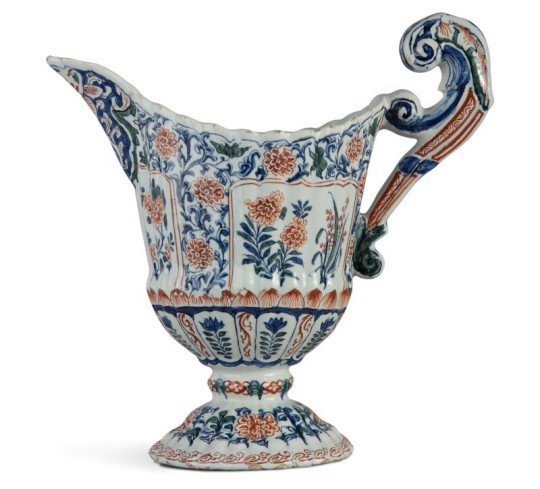
Dutch Helmet-shaped Ewer, polychrome earthenware, ca. 1710
2 notes
·
View notes
Photo


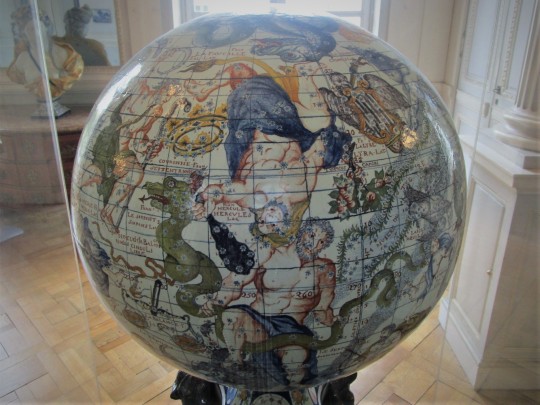




Celestial and Terrestrial Spheres, c. 1725, made in Rouen, France, where the earthenware factories specialized in large polychrome sculptures. These were made for the Château de Bois-Guilbert.
The beautiful celestial sphere is decorated with zodiacal and mythological figures representing the constellations. The base shows the guardian deities of the four elements: Juno for air, Amphitrite for water, Ceres for earth, and Vulcan for fire.
The terrestrial sphere is based on engravings by Guillaume Delisle executed around 1700, including sea monsters. The base has allegorical figures of the seasons: Flora for Spring, Ceres for Summer, Bacchus for Autumn, and Vulcan, the muscular fellow shown above, for Winter. (How is he both Fire and Winter?) The crocodile at the very bottom represents the American continent.
Photos by Charles Reeza at the Musée de la Céramique de Rouen.
#ceramic sculpture#polychrome earthenware#French potteries#antique globe#antique maps#Rouen#France#travel photos
47 notes
·
View notes
Photo

#lecouloir #❤️ #faience #18 #eme #siecle #decor #floral #papillon #polychrome #soupiere #sudouest #34x21 #deco #decoration #beautiful #collection #earthenware #ancient #antiquity #陶器 #古代陶器 #antiquite #vitrine #france #damienarthaud #5 #rueaugustecomte #lyon (à Le Couloir Damien Arthaud) https://www.instagram.com/p/B0it1DDnFtG/?igshid=c5iiwwkd2472
#lecouloir#❤️#faience#18#eme#siecle#decor#floral#papillon#polychrome#soupiere#sudouest#34x21#deco#decoration#beautiful#collection#earthenware#ancient#antiquity#陶器#古代陶器#antiquite#vitrine#france#damienarthaud#5#rueaugustecomte#lyon
1 note
·
View note
Photo

A beauty of a bowl for your #Farmhouse decor. 13 1/3" W by 4 1/4" D - $299 purchase on post or visit us at www.bit.ly/PolychomeEarthenwareBowl #antiques #Tuesday #pottery #earthenware #polychrome #18thCentury #primitives #FrenchCountry #interiors #decorator #interiordesign #bowls #redware #green #splatterware #rustic https://www.instagram.com/p/B-aXdY1gRE8/?igshid=h1s59hpmpoc0
#farmhouse#antiques#tuesday#pottery#earthenware#polychrome#18thcentury#primitives#frenchcountry#interiors#decorator#interiordesign#bowls#redware#green#splatterware#rustic
0 notes
Photo

Mortuary Horse, c. 525, Cleveland Museum of Art: Chinese Art
Size: Overall: 22.3 x 22.3 cm (8 3/4 x 8 3/4 in.)
Medium: dark buff earthenware with polychrome
https://clevelandart.org/art/1929.985
100 notes
·
View notes
Text


Bowl with green, yellow, and brown splash decoration, 10th century. Iran, Nishapur. Islamic.
Earthenware; white slip, incised and splashed with polychrome glazes under transparent glaze (sgraffito ware).
Courtesy Alain Truong
24 notes
·
View notes
Text
#FrogFriday:

Double-Spout Bottle
Nasca, Peru, South Coast, 3rd century
Earthenware, polychrome slip paint
5 × 4 × 3 1/2 in. (12.7 × 10.2 × 8.9 cm.)
BMA 2016.203
on display at Baltimore Museum of Art
#animals in art#museum visit#frog#frogs#Nasca art#Peruvian art#Indigenous art#preconquest art#ceramics#pottery#Baltimore Museum of Art#Feog Friday#ancient art
33 notes
·
View notes
Photo

Delft shoe, one of a pair, 1720, Minneapolis Institute of Art: Decorative Arts, Textiles and Sculpture
polychrome with all over floral design
Size: 4 1/2 x 2 7/16 x 6 1/2 in. (11.4 x 6.2 x 16.5 cm)
Medium: Tin-glazed earthenware
https://collections.artsmia.org/art/8949/
142 notes
·
View notes
Photo
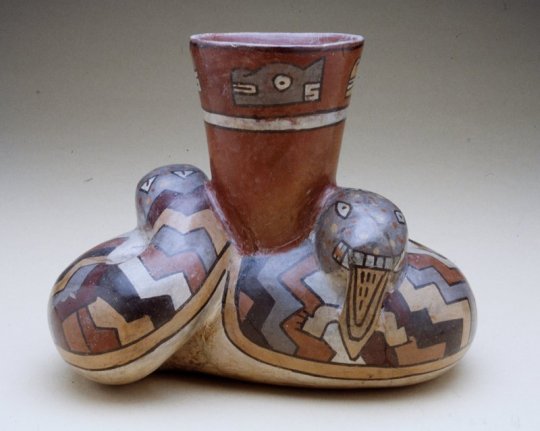
Jar, 11th-14th century, Minneapolis Institute of Art: Art of Africa and the Americas
Jar, wide-mouthed, in the form of a double-headed snake. Deep, flaring neck with a band of puma heads below the rim. Painted in polychrome. Rim chipped. The double-headed snake is a common image throughout ancient traditional beliefs, from the Pacific Coast to the Andes. In this example, the jaguar appears around the neck of the vase in profile, and complements the serpent imagery. Both the snake and the jaguar were encountered in sacred journeys, and were important symbols of shamanic visions and power. This object successfully unites two sacred animals important to traditional beliefs.
Size: 7 x 9 1/4 in. (17.8 x 23.5 cm)
Medium: Polychromed earthenware
https://collections.artsmia.org/art/17258/
25 notes
·
View notes
Photo

Pitcher, ca. 1805, Brooklyn Museum: Decorative Arts
Pitcher, cream-colored earthenware, bulge at center, plain handle, gold decoration painted around top and bottom, border of gold lattice work, overglaze black transfer-printed views: one polychrome, others black. Views: square-rigged three-masted schooner flying American flag with fifteen stars. Trumpeting angel as figurehead. Ship is yellow with black below; water is green. "THE FAME" painted below. Under spout: "JOHN VOSE" in a swagged and scalloped oval. Below is a spread eagle looking left with olive branch and arrows in talons, shield on chest, "PLURIBUS UNUM" on banner in beak, thirteen stars above. Reverse: Memorial to Washington. Large eagle with wings outspread in left foreground. Woman in white on right leans on monument, bowing her head in her hand. Monument in center has a portrait with "GEORGE WASHINGTON" printed below. Monument is an obelisk on a large base, crowned with a low urn. Willows on each side frame the monument. All enclosed in an oval with banner above saying "WASHINGTON IN GLORY" (black on white), banner below reads "AMERICA IN TEARS" (white on black). Condition: Gold decoration badly worn. Eight spots on rim where glaze is gone. One large spot on spout where glaze is chipped. Crack on bottom surrounded by crazing.
Size: Height: 9 3/8 in. (23.8 cm) Base diameter: 8 13/16 in. (22.4 cm) Top diameter: 4 in. (10.2 cm)
Medium: Glazed earthenware
https://www.brooklynmuseum.org/opencollection/objects/402
35 notes
·
View notes
Photo
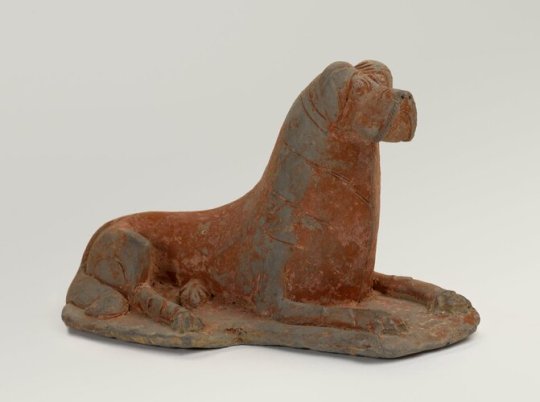
Figure of a Recumbent Dog, early 6th century, Brooklyn Museum: Asian Art
Gray earthenware figure of a recumbent dog on a flat base. The animal is finely sculpted with its head raised in an attentive pose. Its well-articulated features, with a flat, square muzzle. Large pendulous lips and wide-opened eyes carry an alert and dignified expression. The neck and chest are broad and powerful, but the body gradually tapers towards the hindquarters. In profile, the topline is well-defined as it extends from the neck and along the back. The hindquarters are close to the body with the rear left leg tucked under and barely visible. A large and full tail extends downward in a relaxed manner. Shallow incised lines define musculature, markings on the fur, and facial features -- particularly the snout, the ridge of the nose, eyes, and two down-turned ears. Four parallel finely incised lines encircle the dog's chest; two short incised lines are found on each of the forelegs; three brief lines are located on the rear right leg. The figure was mold-made with possible hand-built additions. The gray earthenware body is primarily covered with red polychrome with traces of a buff-colored slip or pigment. The bottom of the base has no polychrome. Adhering to the bottom of the base are two paper inventory labels from C.T. Loo, Paris and J.J. Lally & Co. New York. Thermo luminescence testing done by Echo D. Evetts on June 25, 1997 on base, dating the object to the period consistent to the period of manufacture. As one of the earliest domesticated animals in China (by the 4th-5th millennium BCE), the dog functioned as guard and hunting animal and was also a symbol of fidelity. Canine remains have been found at the feet of the deceased in several Neolithic burial mounds and Shang tombs. Earthenware representations of dogs exist as early as the Neolithic period, but date generally from the Han to Tang dynasties as mingqi, or funerary ware. Examples of sturdy-looking hunting and working breeds appear most frequently either covered with glaze or with polychrome and in a variety of positions. The breed depicted here seems to derive from the mastiff family, which has an extended lineage in China as a working dog. Stylistically speaking, the sharp edge of the back beginning from the neck is comparable to earthenware representations of caparison horses and other dogs from the Six Dynasties period. Condition: Good. The red polychrome and white slip have been worn off in certain areas, with the most prominent being around the front right shoulder.
Size: 3 5/8 x 6 1/4 x 3 5/8 in. (9.2 x 15.8 x 9.2 cm)
Medium: Gray earthenware with red polychrome
https://www.brooklynmuseum.org/opencollection/objects/159018
25 notes
·
View notes